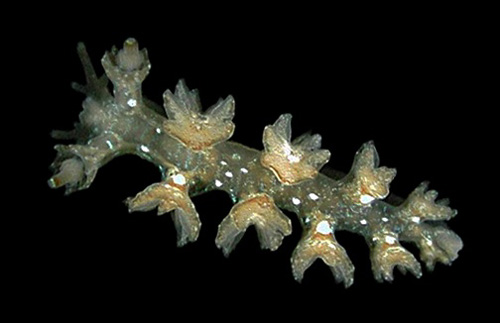_______________
Additional Photos

young, 2 mm

|
Hancockia sp. #1

Maximum size: 6 mm.
Identification:
This
animal is translucent tan with a dusting of tiny white flecks on
the body, cerata and rhinophoral sheaths. There are
a handful of irregularly-shaped opaque white spots scattered over the
body and a single circular opaque white spot on the posterior base of
each rhinophoral sheath and on the inner base of each ceras.
There are five pairs of dorsal lobes (or cerata) which branch into hand-shaped
groups of finger-like processes facing outward. The first pair is
directly opposite and the remaining four become progressively less
directly paired. The rhinophores are tipped with brown and white and
are
retractile within sheaths which have papillate margins. The velar lobes
have three or possibly four finger-like processes of varying lengths.
Ducts from the liver form two lines running anteriorly and posteriorly from
behind the first pair of dorsal lobes, then into the rhinophores and other lobes, respectively.
Natural history:
Hancockia sp. #1
is known from only two animals that were found in Halimeda kanaloana beds at depths of 14-33
m (45-108 ft). The sites are sometimes exposed to strong currents.
Distribution:
Maui.
Taxonomic notes: It was first
recorded in Hawaii from Makena, Maui by PF on May 19, 1995.
Photo: PF: 6
mm: Makena, Maui; May 19, 1995.
Observations and comments:
Note
1: ( )
|
|


